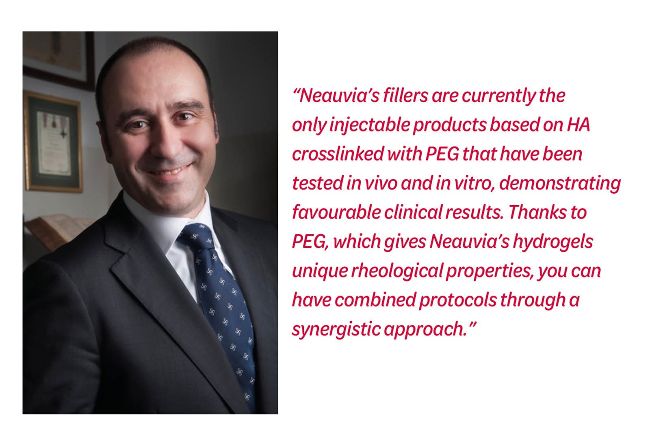Distinguished by its Polyethylene Glycol Diacrylate (PEGDE) crosslinking, Neauvia’s technology boasts diverse molecular weights and chain lengths.1 This results in high conformational flexibility and shape modification without structural damage, setting the stage for a remarkable transformation in the world of aesthetic procedures.
Neauvia’s strategic choice of PEG sets it apart, offering distinctive properties that elevate the efficacy of its gels. Exhibiting high viscoelasticity and cohesivity, the gels mirror the mechanical properties of natural skin tissues. The immediate results achieved through the PEG-HA Fillers, combined with thermo-dynamic and thermo-stability properties, allow for the implementation of versatile and effective combined protocols.
Ensuring a high-safety profile, Neauvia fillers have no pathologic inflammatory reactions* and no residual remains.1 The reversible filling aspect adds an extra layer of confidence, ensuring safety and patient satisfaction.

Prof Nicola Zerbinati, dermatologist and Neauvia scientific director, Italy
Neauvia’s research and development team has meticulously crafted monophasic and cohesive hydrogels, showcasing distinctive properties and gel consistencies. The patented SXT integrates different molecular weights and chain lengths, influencing the product’s behaviour under mechanical stress during injection and throughout its life in the tissues.
Each filler in Neauvia’s line is enriched with proteinogenic amino acids, glycine and L-proline, integral to the biosynthesis of proteins.2 These amino acids contribute to fine-tuning the rheological properties and swelling resistance, ensuring better control of the hydrogel’s swelling capacity in the post-implant phase.3
NEAUVIA
To find out more about the transformative potential of Neauvia PEG-HA Fillers, visit neauviachannel.com.
REFERENCES
*None detected so far with the use of Neauvia PEG-HA Fillers.
1. Clinical data on file
2. Zerbinati, N.; Sommatis, S.; Maccario, C.; Capillo, M.C.; Grimaldi, G.; Alonci, G.; Protasoni, M. Rauso, R.; Mocchi, R. Toward Physicochemical and Rheological Characterization of Different HA Dermal Fillers Cross-Linked with Polyethylene Glycol Diglycidyl Ether. Polymers 2021, 13, 948.
3. Marino F, Cosentino M, Legnaro M,et al. Immune profile of hyaluronic acid hydrogel polyethylene glycol crosslinked: An in vitro evaluation in human polymorphonuclear leukocytes.
4. Zerbinati, N.; Capillo, M.C.; Sommatis, S.; Maccario, C.; Alonci, G.; Rauso, R.; Galadari, H.; Guida, S.; Mocchi, R. Rheological Investigation as Tool to Assess Physicochemical Stability of a Hyaluronic Acid Dermal Filler Cross-Linked with Polyethylene Glycol Diglycidyl Ether and Containing Calcium Hydroxyapatite, Glycine and L-Proline. Gels 2022, 8, 264.
5: Zerbinati N, Lotti T, Monticelli D, Martina V, Cipolla G, D’Este E, Calligaro A, Mocchi R, Maccario C, Sommatis S, Lotti J, Wollina U, Tchernev G, França K. In Vitro Evaluation of the Sensitivity of a Hyaluronic Acid PEG Cross -Linked to Bovine Testes Hyaluronidase. Open Access Maced J Med Sci.